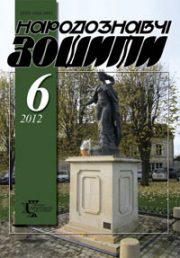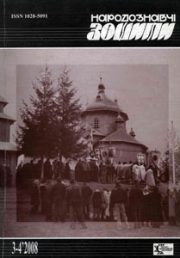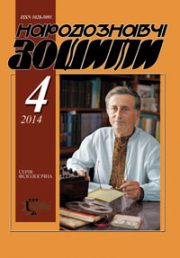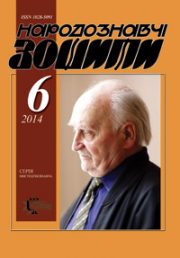The Ethnology Notebooks. 2024. № 2 (182), 360—374
UDK [39:728.6](477.83/.84+86)”19/20″:930.2
DOI https://doi.org/10.15407/nz2025.02.360
RADOVYCH Roman
- ORCID ID: http://orcid.org/0000-0002-1900-8948
- Doctor of Sciences in History, Senior Researcher
- of the Institute of Ethnology
- of the National Academy of Sciences of Ukraine,
- in the Department of Historical Ethnology,
- 15, Svobody Avenue, 79000, Lviv, Ukraine,
- Contacts: e-mail: radovychroman@gmail.com
Abstract. Mutual assistance during construction («toloka») was extremely widespread in the Ukrainian ethnic lands. This particularly applied to the construction of buildings that involved significant use of clay (or clay-straw mixtures), which required a lot of time and labor. Unfortunately, this issue, both across Ukraine and in specific historical and ethnographic regions, as well as in ethnographic districts, is still relatively underexplored in the special ethnographic literature. Therefore, a more detailed examination of labor mutual aid during construction is quite important, which also defines the relevance of the proposed study.
The author of the work aims to determine the features of collective assistance during the construction of rural homes in the territories of Pokuttya, Western Podillya, and Opillia.
The object of the study is traditional construction, and the subject is the specific features of collective assistance («toloka») during construction work.
The methodological basis of the study is the principle of historicism, and methods of field ethnographic research, as well as general scientific (analysis and synthesis, induction and deduction) and specialized scientific methods (retrospective, comparative-historical, statistical methods, typological analysis, and others), were used.
The research area covers the territories of Pokuttya, Opillia, and Western Podillya (within parts of Lviv, Ivano-Frankivsk, and Ternopil regions). The chronological boundaries of the study are defined by the source material, which covers the 20th and early 21st centuries.
Labor collective mutual assistance during construction work, both in Galicia and generally in Ukraine, is still rather superficially covered in the special ethnological literature. Some features of «toloka» are considered in the works of I. Greben, Y. Taras, and R. Tarnavskyi. Therefore, the primary source base for this study consists mainly of the author’s field materials and some published field materials by R. Tarnavskyi.
Keywords: Pokuttya, Opillia, Western Podillya, construction, collective assistance, clay-straw mixture, valls.
Received 1.04.2025
REFERENCES
- Greben, I. (1994). Rituals associated with the construction of rural housing. Podillya: historical and ethnographic study (Pp. 243—250). Kyiv [in Ukrainian].
- Greben, I. (1999). Home in the system of customs and beliefs. Ukrainian: historical and ethnographic monography in two books (Vol. 2, pp. 57—64). Opishne: Ukrainian Genre Studies [in Ukrainian].
- Taras, Y. (2010). Collective help in the construction of Ukrainians in Moldova. In: the Notes of the NTSh (Vol. CCCLІХ, pp. 265—272). Lviv: NTSh [in Ukrainian].
- Tarnavskyi, R. (2012). Toloka and teamwork in the public life of the peasants of the Southwestern ethnographic region of Ukraine: a cultural-genetic problem. Thesis for the degree of candidate of historical sciences. Specialty 07.00.05 — ethnology. Lviv [in Ukrainian].
- (2020). Ethnographic image of modern Ukraine. Corpus of expeditionary folklore and ethnographic materials. People’s housing culture. Ecology and organization of habitat (Vol. 9) [in Ukrainian].
- Yakymovych A. (1998). Traditional folk dwelling of Pokuttya of the late nineteenth and early twentieth centuries. Proceedings. Museum of Folk Architecture and Life in Lviv (Issue I, pp. 58—63) [in Ukrainian].
- Kolberg, O. (1882). Penetration: ethnographic picture (Vol. 1). Krakow: In the printing house of the Jagellonian university [in Polish].
- Radovych, R. (1995). Traditional rural housing in Opil in the second half of the 19 — early 20 centuries. In: the Notes of the NTSh (Vol. CCXXX, pp. 79—106). Lviv: NTSh [in Ukrainian].
- Bodrevych, O.I. (1976). Report on the scientific expedition to Podilla. Personal Archive of the Author [in Ukrainian].
- Radovych, R. (2010). Traditional housing of Ukrainians in the southern part of Podillya in the second half of the 19th — beginning of the 20th centuries: structural and technological aspect (based on materials of the Khmelnytsky region). Bulletin of the University of Lviv. Series Historical (Vol. 45, pp. 437—462). Lviv: Lviv National University I. Franko [іn Ukrainian].
- Myloradovych, V. (1991). The life-being of a Luben peasant. Ukrainians: popular beliefs, belief, demonology (Pp. 170—341). Kyiv: Lybid [in Russian].
- Ivanov, P. (2014). Folk customs, beliefs, signs, proverbs, and riddles related to the Little Russian house (Materials for characterizing the worldview of the peasant population of the Kupyansk district). Field. Collection of scientific works on the history, theory, and methodology of field research (Vol. 1, pp. 223—236). Kyiv [in Russian].
- Radovych, R. (1996). Rural housing of the late 19 — early 20 centuries in the south of Podillya (based on materials from Borshchiv district). Chronicle of Borshchivschyna: Historical and Local Studies Collection (Issue VІІІ, pp. 58—66). Borschiv: Source [in Ukrainian].
- Svyrida, R. (2008). Traditional housing of Shevchenko’s Zvenyhorodshchyna. At the guard of Ukrainian folk culture (Pp. 207—211). Kyiv [in Ukrainian].
- Hrushevskyi, M. (2002) From the life of peasants in the Chihyryn region. Sights of Ukraine: history and culture, 2, 127—135 [in Ukrainian].
- Shevchenko, L. (1926). Customs related to building deposits. Original citizenship. His remains in Ukraine (Issue 1—2, pp. 87—95). Kyiv [in Ukrainian].







